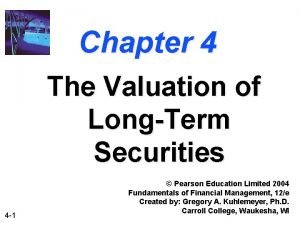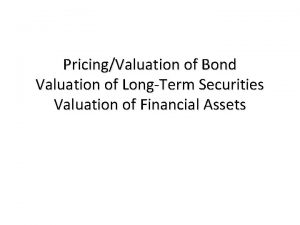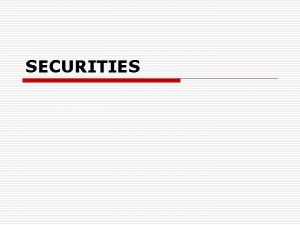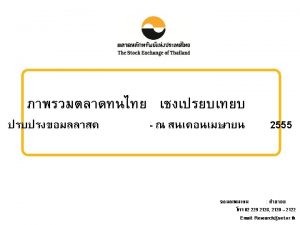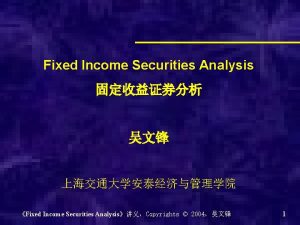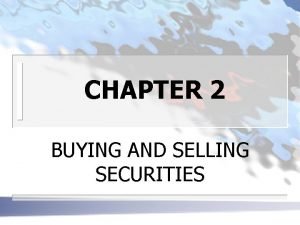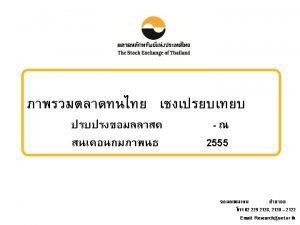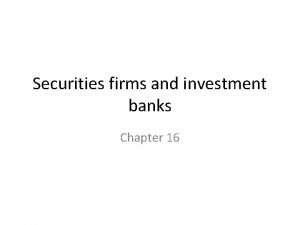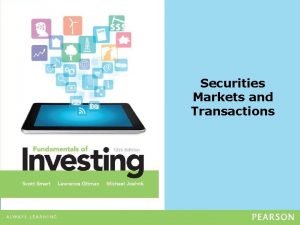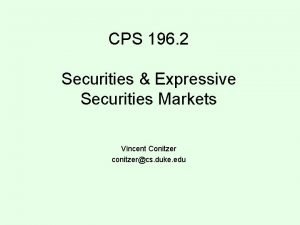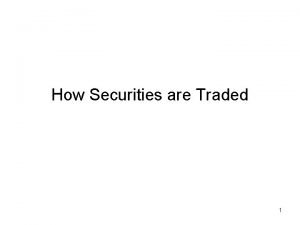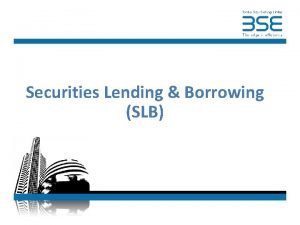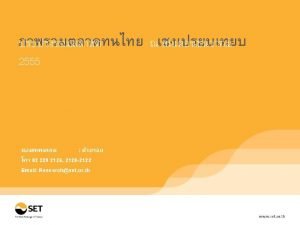VALUATION OF SECURITIES VALUATION Valuation is the process




























- Slides: 28

VALUATION OF SECURITIES

VALUATION • Valuation is the process of determining the worth of an asset at zero period of time. • Securities here include Equity share, Preference share and Bond/Debenture. • Value of security is closely related to the present value of the future cash streams. Called as Intrinsic Value. • The Value realized at the end of maturity of the security is Terminal Value. • Different Assets may be valued differently with different perspective.

Securities/Assets could be valued on the basis of following 1. Book Value: It is an accounting concept. It is the difference between book value of total asset and book value of total External liability. Also known as net worth/Shareholders fund. 2. Market Value: The current price at which the security can be sold is market price. 3. Going Concern Value: The amount a business concern could realize if the business is sold as an operating unit is known as going concern value. Going Concern Value depends upon the ability to generate sales and profits in the future. 4. Liquidating Value: The amount which the owners would realize after having liquidated the business it firms liquidation value. It may also be zero. 5. Replacement Value: It is the amount which is required to replace the existing assets.

6. Capitalized Value: The Capitalized value of a financial asset is the sum of present value of cash flows from an asset. It is also known as Economic Value. • It is the most relevant concept of valuation of securities. • We are going to discuss this concept only.

• VALUATION OF BOND/DEBENTURES

An investor purchases a bond whose face value is 1000, maturity period is 5 years and coupon rate is 7%. The required rate of return is 8%. What amount he should be willing to pay now to purchase the bond if it matures at par.

An investor purchases a bond whose face value is 1000, maturity period is 5 years and coupon rate is 7%. The required rate of return is • 8%. What amount he should be willing to pay now to purchase the bond if it matures at par.


VALUATION OF ZERO COUPON BOND •

YIELD TO MATURITY • The yield to maturity, book yield or redemption yield is rate of return earned by an investor who purchases bonds and holds it till maturity. • Yield to maturity is the discount rate at which the sum of all future cash flows from the bond (coupons and principal) is equal to the current price of the bond. • Same as internal rate of return.

Valuation of Preference •

VALUATION OF EQUITY • On the basis of Accounting information • On the basis of Dividend • On the basis of Earnings

VALUATION OF EQUITY ON THE BASIS OF ACCOUNTING INFORMATIO •


VALUATION OF EQUITY ON THE BASIS OF DIVIDEND •



ON THE BASIS OF GROWTH OF DIVIDEND •


VALUATION OF SHARES ON THE BASIS OF EARNINGS 1. Walter Model 2. Gordon Model 3. P/E Ratio

P/E RATIO •

CAPITAL ASSET PRICING MODEL (CAPM)

Capital Asset Pricing Model • The capital asset pricing model (was developed in 1952 by Harry Markowitz. • It was later adapted by other economists and investors, including William Sharpe, Merton miller, Jack Treynor, John Lintner. • Sharpe, Markowitz and Merton Miller jointly received the 1990 Nobel Prize in Economics for this contribution to the field of financial economics • CAPM describes the relationship between an investor’s risk and the expected return. It is designed to help model the pricing of higher-risk securities. • In other words, we can say that it is expected rate of return on high risk securities • According to the CAPM theory, the expected return of a particular security or a portfolio is equal to the rate on a risk-free security plus a risk premium.

ASSUMPTIONS OF CAPM 1. The market is perfect: there are no taxes, there are no transaction costs, securities can be bought and sold freely and easily, information is available freely and easily. 2. The investors are risk averse i. e. they try to avoid risk. 3. Investors have homogenous expectations of returns. 4. Investors can borrow and lend freely at the riskless rate of interest. 5. All investors aim to maximize economic value.

Ki = Rf + β(Rm –Rf ) Where, Ki = the required return on security Rf = Risk free rate of return β = The beta (Risk) of the security Rm = Market rate of return Rm–Rf = Risk Premium The Capital Asset Pricing Model (CAPM) is a model that describes the relationship between expected return and risk of investing in a security. It shows that the expected return on a security is equal to the risk-free return plus a risk premium, which is based on the beta of that security.

Overall stock market has a beta of 1. 0 1. β > 1 =high volatility, high risk, aggressive security 2. β < 1 = Low volatility, low risk, defensive security 3. β = 1 = same volatility as the market.

The current interest rate on Indore municipal bond is 3%. And the NSE Nifty is expected to bring in returns of 9% over the next year. Mr. Aman kanojia wants to purchase shares of RIL and he has learned that the beta of RIL is 1. 9. What rate of return should Mr. Kanojia expect from the shares of RIL.

 Fixed income introduction
Fixed income introduction The invoice price of a bond is the ______.
The invoice price of a bond is the ______. Valuation of long term securities
Valuation of long term securities Hát kết hợp bộ gõ cơ thể
Hát kết hợp bộ gõ cơ thể Ng-html
Ng-html Bổ thể
Bổ thể Tỉ lệ cơ thể trẻ em
Tỉ lệ cơ thể trẻ em Voi kéo gỗ như thế nào
Voi kéo gỗ như thế nào Tư thế worms-breton
Tư thế worms-breton Chúa sống lại
Chúa sống lại Môn thể thao bắt đầu bằng từ đua
Môn thể thao bắt đầu bằng từ đua Thế nào là hệ số cao nhất
Thế nào là hệ số cao nhất Các châu lục và đại dương trên thế giới
Các châu lục và đại dương trên thế giới Công của trọng lực
Công của trọng lực Trời xanh đây là của chúng ta thể thơ
Trời xanh đây là của chúng ta thể thơ Mật thư tọa độ 5x5
Mật thư tọa độ 5x5 Làm thế nào để 102-1=99
Làm thế nào để 102-1=99 độ dài liên kết
độ dài liên kết Các châu lục và đại dương trên thế giới
Các châu lục và đại dương trên thế giới Thể thơ truyền thống
Thể thơ truyền thống Quá trình desamine hóa có thể tạo ra
Quá trình desamine hóa có thể tạo ra Một số thể thơ truyền thống
Một số thể thơ truyền thống Cái miệng bé xinh thế chỉ nói điều hay thôi
Cái miệng bé xinh thế chỉ nói điều hay thôi Vẽ hình chiếu vuông góc của vật thể sau
Vẽ hình chiếu vuông góc của vật thể sau Biện pháp chống mỏi cơ
Biện pháp chống mỏi cơ đặc điểm cơ thể của người tối cổ
đặc điểm cơ thể của người tối cổ V cc cc
V cc cc Vẽ hình chiếu đứng bằng cạnh của vật thể
Vẽ hình chiếu đứng bằng cạnh của vật thể Fecboak
Fecboak


